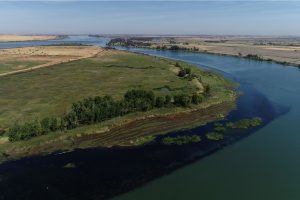Published Date:
November 15, 2018
Editor’s note: The following article is part of a continuing series highlighting the California EcoRestore Initiative, which seeks to restore 30,000 acres of habitat in the Sacramento-San Joaquin Delta by 2020. California EcoRestore is an umbrella program that includes habitat restoration efforts implemented and funded by the Departments under California Natural Resources Agency including Department of Water Resources, Department of Fish and Wildlife, and the Delta Conservancy.
 DWR recently completed construction that transforms an island in the heart of the Sacramento-San Joaquin Delta from a managed leveed site to an open tidal wetland reminiscent of the historical landscape.
DWR recently completed construction that transforms an island in the heart of the Sacramento-San Joaquin Delta from a managed leveed site to an open tidal wetland reminiscent of the historical landscape.
Decker Island (Solano County) is located amidst the largest estuary on the West Coast, between freshwater and saltwater, where the endangered Delta smelt are concentrated. Over time, the Delta ecosystem and food web that native fish species depend on has been greatly diminished.
The Decker Island Tidal Habitat Restoration Project, which broke ground in August 2018, converts an existing wetland into tidal habitat. Under the plan, DWR breached levees along the perimeter of the 140-acre site, allowing water from the Sacramento River to move through the marshland. As the water flows out of the marshland, it carries microscopic plankton, plant particles, and other nutrients across the Delta’s waterways, where the tiny bits are eaten by Delta smelt and other fish and wildlife species.
“These tidal wetlands are the bread baskets of the Delta. This is where the basis of the food web is created,” said Dennis McEwan, Chief of the State Water Project Mitigation and Restoration Branch within DWR.
More than a century ago, levee systems were built up to protect agricultural land and urban areas from the seasonal and tidal waters. Since the 1800s, tidal wetland habitat in the Delta has declined from an estimated 350,000 acres to about only 10,000 acres. This loss of habitat has contributed to the steep decline of native fish and wildlife species. The restoration projects under California EcoRestore, such as this effort on Decker Island, seek to reverse this trend by providing the habitat and food sources needed to boost fish survival rates.
Decker Island is one of 13 projects planned and implemented by DWR’s Fish Restoration Program charged with restoring 8,000 acres of tidal wetland habitat in the Delta and Suisun Marsh, as required mitigation for the State Water Project and Central Valley Project long term operations. This effort has been a close partnership between DWR and the California Department of Fish and Wildlife (CDFW). CDFW will carry out the on-site biological monitoring to ensure the site functions as it was designed and to inform future restoration efforts.
Contact:
Allen Young, Information Officer, Department of Water Resources
916-653-3925 | allen.young@water.ca.gov


